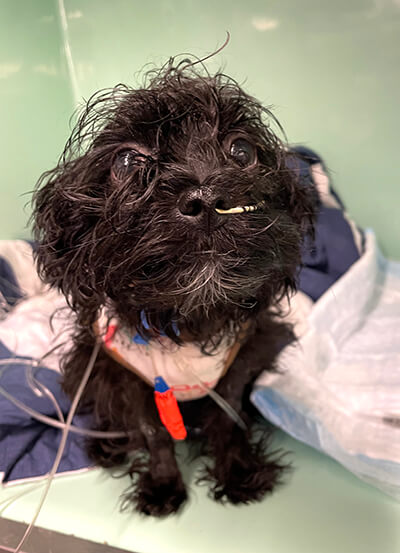University of Pennsylvania issued the following announcement on May 26.
When Olive, the four-month-old Shih Tzu mix, became critically ill with respiratory distress, clinicians at Penn Vet’s Ryan Hospital spent a week collaborating on intensive treatment.
In 2021, the Martino family welcomed a new puppy named Olive. But despair soon followed when the four-month-old Shih Tzu mix became critically ill. On an otherwise normal Thursday afternoon, the family heard Olive crying from her hiding place under the sofa. She was breathing rapidly and had coughed up small droplets of blood.
 Olive, the brave Shi Tzu. (Image: Penn Vet News)
Olive, the brave Shi Tzu. (Image: Penn Vet News)
Their primary care veterinarian ruled out toxicity and parvovirus, but chest X-rays showed fluid in Olive’s lungs—the clinical diagnosis is non-cardiogenic pulmonary edema—and air leaking from her lungs in her chest cavity. Called a pneumothorax, air surrounding one or both lungs can be a life-threatening condition that keeps the lungs from expanding and an animal from getting enough oxygen.
The veterinarian referred Olive to Penn Vet’s Ryan Hospital, where she would be one of 9,000 small animals to come through the hospital’s Emergency Services last year and one of 1,200 cases to receive intensive care.
Selimah Harmon, an emergency and critical care resident, was primary clinician on Olive’s case, working with supervising clinician Deborah Silverstein, professor of emergency and clinical care. Olive arrived at Emergency Services (ES) just in time. Those first hours were critical.
“Olive was in severe respiratory distress by the time she got to ES,” says Silverstein. “The team was limited in what they could do diagnostically because she needed oxygen and was placed in an oxygen cage. She remained on oxygen overnight and was transferred to the ICU in the morning. Her breathing remained labored even with extra oxygen. When I met her in the morning, I knew her prognosis was grave unless we placed her on a ventilator. But the pneumothorax complicated her case. The pressurized air entering her lungs from the ventilator could cause further air leakage into her chest.”
Over two days, Olive’s care team made regular adjustments to her medications and ventilator settings. “She spiked a fever at one point, and we worried about an infection so we started her on IV antibiotics,” says Harmon. “By the third day, Sunday, she was showing improvement. Her fever resolved and lung functions were closer to normal. We took her off the ventilator and placed her back in the oxygen cage. By Tuesday, now the fifth day of her stay, she no longer needed oxygen support. The next day, on Wednesday, nearly a week after arriving at Penn Vet, Olive went home. She came in for a follow-up a week later, and we were thrilled with her progress.”
Olive’s care team sites the collaborative environment at Ryan Hospital for Olive’s progress. “It takes a lot of collaborative effort to get an animal like this stabilized for thorough diagnostics and appropriate treatment,” says Silverstein. “The entire process is a well-oiled machine of fine tuning and close monitoring. Young animal patients can be so resilient; they’re little fighters. If I have one motto for pediatrics, it’s don't ever give up on a puppy or a kitten. They can have such amazing recoveries from what appears to be severe, life-threatening disease. These tiny animals will fight to survive if we can help them.”
Original source can be found here.






 Alerts Sign-up
Alerts Sign-up